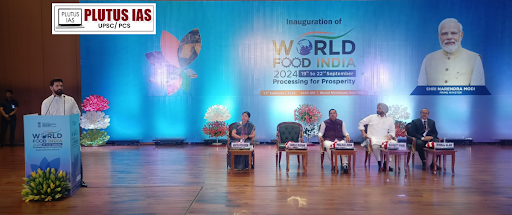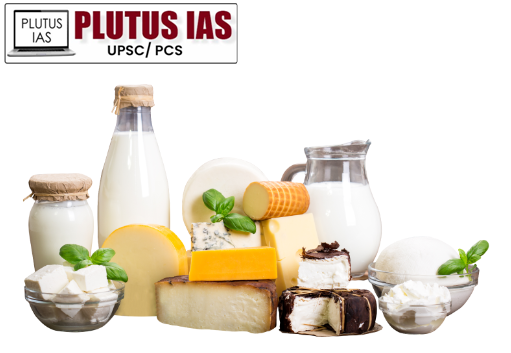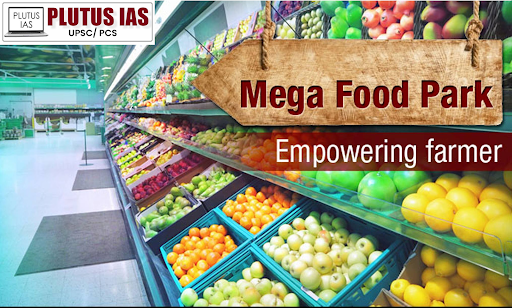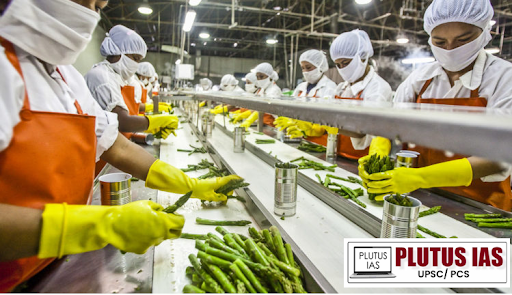25 Sep Nourishing the Nation: The Significance of India’s Food Industry
This article covers “Daily Current Affairs” and topic details of The Rise of Food Processing: Fueling India’s Economic Advancement
Syllabus mapping:
GS-3: Agriculture: Indian food processing industry.
For Prelims:
What are the schemes related to the food processing Industry, Key facts related to it, and government policies?
For Mains:
What is the current status of the food processing industry and the significance of the food processing industry in rural development, what challenges are faced by the sectors, and what are the way forward?
Why in the News?
The four-day mega event, World Food India, was concluded in Delhi. This gathering aims to showcase and promote the country’s food processing and agricultural potential.

Current status of the food processing industry in India:

GDP contribution
Economic Contribution: Share of agri and food processing GVA in Total Economy: 18.3%
Employment Impact: Share in Total Employment: 12.22%
Export Performance: Exports of Agricultural and Processed Food Products: $51 billion
Cropping Intensity: 141.6%
Global position:
World’s Largest Producers: Spices, Milk, Pulses
World’s Second-Largest Producers: Tea, Sugarcane, Wheat, Fruits, Vegetables
Market Growth:
Export Growth: Agricultural and processed food product exports rose 13% to $19.69 billion in the first nine months of FY 2022-23.
Processed Food Export Share: Increased from 13.7% (2014-15) to 25.6% (2022-23).
Foreign Direct Investment (FDI): Total FDI reached $12.58 billion (Apr 2000 – Mar 2024), making up 1.85% of total FDI.
Export Highlights:
Rice Exports: In FY 2023-24, India exported 11.1 million tonnes of non-basmati rice and 5.2 million tonnes of basmati rice.
Total Exports: Agricultural and processed food exports neared $51 billion in 2022-23, with key markets including the USA, Bangladesh, UAE, and Vietnam.
Future Projections:
Market Size: Expected to reach $535 billion by 2025, growing at a CAGR of 15.2%.
Consumer Spending: Projected to hit $6 trillion by 2030, with increased demand for processed food in Tier-II and Tier-III cities.
Government Policies: India’s Food Processing Sector – A Sunrise Industry

1. Pradhan Mantri Kisan Sampada Yojana (PMKSY): Develops modern food processing infrastructure and enhances supply chain management from farm to retail.
2. Pradhan Mantri Formalisation of Micro Food Processing Enterprises (PMFME): Supports the growth of individual micro-enterprises in the unorganized food processing segment.
3. Production Linked Incentive Scheme for Food Processing Industry (PLISFPI): Encourages domestic manufacturing and exports, targeting investment in Strategic Focus:
4. Agri-Infra Fund: Aimed at developing rural infrastructure for post-harvest management and marketing of agricultural products to enhance supply chain efficiency.
5. E-technology: Focuses on leveraging technology to streamline agricultural marketing, enabling farmers to access real-time market information and improve sales.
6. Mission for Integrated Development of Horticulture (MIDH): Aim to promote the holistic development of horticulture through improved production, post-harvest management, and marketing strategies.
7. One District One Product (ODOP): Seeks to promote specialized products in each district to enhance local production, create jobs, and boost regional economic growth.
8. Particular focus: The government aims to position India as a global hub for “Shree Anna” (millets).
9. FDI policy: 100% FDI is allowed under automatic and government-approved routes for food processing and trading.
10. Food Processing Fund: This fund is set up in NABARD to provide direct term loans at affordable rates of interest to food processing units and Designated Food Parks (DFPs
Significance of the Food Processing Industry

1. Employment Generation: The sector employs approximately 12.22% of India’s workforce, providing millions of jobs and enhancing livelihoods.
2. Agricultural Productivity: Food processing increases the value of agricultural produce, contributing to a 13% rise in agricultural and processed food exports, thereby enhancing farmers’ incomes.
3. Women’s Empowerment: The industry provides numerous opportunities for women, particularly in rural areas, fostering entrepreneurship and financial independence.
4. Regional Development: Establishing food processing units in rural and semi-urban areas promotes local economies, supporting infrastructure and service growth.
5. Globalization of Indian Products: Increased processed food exports reached nearly $51 billion in 2022-23, positioning India as a competitive player in global markets.
6. Self-Reliant India: The focus on domestic processing reduces reliance on imports, aligning with the government’s vision for a self-sufficient economy.
7. Poverty Eradication: By creating diverse income sources, the industry helps lift families out of poverty, contributing to overall economic stability.
8. Boost in Local Demand: Urbanization drives local food demand, stimulating economic growth and supporting the goals of the Mission LiFE initiative.
9. Research and Innovation: The sector encourages R&D investments, leading to innovative processing techniques and sustainable practices that improve efficiency and product quality.
10. Food security: The food processing industries play a crucial role in providing good nutritious food to millions of people at low costs.
Challenges Facing the Food Processing Sector
1. Infrastructure Deficiencies: Many local areas lack adequate processing and storage facilities, leading to high post-harvest losses estimated at 15-20%.
2. Lack of Awareness: Farmers often lack knowledge about modern processing techniques and market trends, which hampers productivity and profitability.
3. Unorganized Market: The sector is highly fragmented, with around 90% of food processing units being small-scale, making it difficult to achieve economies of scale.
4. Market Linkage Issues: Weak connections between producers and consumers result in inefficient supply chains, affecting price stability and farmer incomes.
5. Sector-Specific Challenges: Areas like milk and dairy processing face unique obstacles, including seasonal supply fluctuations and inadequate cold chain infrastructure.
6. Quality Concerns: Indian processed food quality often falls short compared to international standards, such as those of the Australian food processing industry, impacting export potential.
7. Lack of R&D Investment: Insufficient investment in research and development from the private sector limits innovation and adoption of new technologies in processing.
8. Exploitation of Small Producers: Small farmers often receive low prices due to market dominance by larger players, affecting their livelihoods and sustainability.
9. Sanitary and Phytosanitary Restrictions: Stringent regulations from importing countries can hinder exports, as compliance with international food safety standards is often challenging for small producers.
10. Climate Change Impacts: Changing weather patterns affect crop yields and resource availability, disrupting supply chains and threatening the reliability of raw materials for food processing.
The Way Forward to make the sunrise sector an economic powerhouse:
1. Government Intervention: Enhance infrastructure through schemes like Pradhan Mantri Gram Sadak Yojana and Agri-Infra Fund for better warehousing and roads.
2. FPO Credit: Promote Farmer Producer Organizations (FPOs) under Priority Sector Lending to improve access to credit for small farmers.
3. Technology Utilization: Implement technology solutions like E-GAM to streamline processes and improve efficiency.
4. Export-Oriented Production: Focus on schemes like Production Linked Incentive (PLI) to boost export potential in processed foods.
5. Increase Food Processing Exports: Aim for higher exports through initiatives under the National Food Processing Policy.
6. Organizing Small Farmers: Group small farmers into FPOs to facilitate better market access and economies of scale.
7. Research and Development: Leverage programs under the Indian Council of Agricultural Research (ICAR) for agricultural innovation and technology transfer.
8. One District, One Product: Promote regional growth and specialization through the One District One Product (ODOP) initiative.
9. Boost Local Demand: Encourage local consumption through programs like the Mission for Integrated Development of Horticulture (MIDH).
10. Online Marketing Platforms: Utilize digital platforms for marketing, such as eNAM (National Agriculture Market), to enhance market reach and efficiency.
Conclusion:
India’s food processing sector can significantly enhance the livelihoods of millions of small and marginal farmers. To harness this potential, collaboration between the government and private players is crucial. This partnership will drive investments in infrastructure, technology, and innovation, empowering producers and creating an organized market. Emphasizing sustainable practices and value addition will further contribute to rural development. Collectively, these efforts will elevate India’s position in the global food market and promote economic growth.
Download plutus ias current affairs eng med 25th Sep 2024
Prelims Question:
Q. Consider the following commodities:
1. Wheat
2. Tea
3. Milk
4. Pulses
In how many mentioned above commodities, India is the largest producer in the world?
A. Only one
B. Only two
C. Only three
D. All four
ANSWER: B
Mains Question:
In India, the food processing industry has the immense potential to eradicate poverty in rural areas and improve the lives of millions of farmers. Suggest the way how this potential can be untapped.
(Answer in 250 words)




No Comments